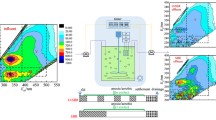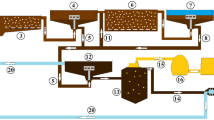Abstract
To treat piggery wastewater efficiently, the hydrolysis of urea (mainly derived from swine urine) in piggery wastewater with the change of sewage pH must be considered. Using activated sludge, piggery wastewater was treated in a sequencing batch reactor (SBR), and the effects of influent pH on SBR processing efficiency, sludge settle ability, and sludge activity were investigated. The results showed that a high influent pH value contributed to the improvement of the removal rate of ammonia nitrogen and reduction of the chemical oxygen demand (COD). When the influent pH was between 9.0 and 9.5, the removal rate of ammonia nitrogen was higher than 90%, and the reduction of COD from its original value was 80%. The influent pH had a greater influence on sludge concentration and sludge activity. When the influent pH increased from 7.0 to 9.5, the sludge concentration increased from 2,350 to 3,947 mg/L in the reactor, and the activities of ammonium oxidizing bacteria (AOB) and nitrite oxidizing bacteria (NOB) first increased and then decreased. When the influent pH was 9.0 and 8.0, the maximum values (0.48 g O2/(g MLSS/day) and 0.080 g O2/(g MLSS/day)) were reached, and the sludge settling ratio was nearly steady between 20 and 35% in each reactor.
Similar content being viewed by others
References
Kim, W., S. G. Shin, K. J. Cho, C. Lee, and S. Hwang (2012) Performance of methanogenic reactors in temperature phased two-stage anaerobic digestion of swine wastewater. J. Biosci. Bioeng. 114: 635–639.
Rajagopal, R., P. Rousseau, N. Bernet, and F. Beline (2011) Combined anaerobic and activated sludge anoxic/oxic treatment for piggery wastewater. Bioresource Technology. 102: 2185–2192.
Song, Y. H., G. L. Qiu, P. Yuan, X. Y. Cui, J. F. Peng, P. Zeng, L. Duan, L. C. Xiang, and F. Qian (2011) Nutrients removal and recovery from anaerobically digested swine wastewater by struvite crystallization without chemical additions. J. Hazardous Mat. 190: 140–149.
Liu, Y. H., S. Kumar, J. H. Kwag, J. H. Kim, J. D. Kim, and C. S. Ra (2011) Recycle of electrolytically dissolved struvite as an alternative to enhance phosphate and nitrogen recovery from swine wastewater. J. Hazardous Mat. 195: 175–181.
Lahav, O., Y. Schwartz, P. Nativ, and Y. Gendel (2013) Sustainable removal of ammonia from anaerobic-lagoon swine waste effluents using an electrochemically-regenerated ion exchange process. Chem. Eng. J. 218: 214–222.
Deng, L. W., P. Zheng, and Z. A. Chen (2006) Anaerobic digestion and post-treatment of swine wastewater using IC-SBR process with bypass of raw wastewater. Proc. Biochem. 41: 965–969.
Takaaki, M., C. M. Liao, and X. D. Feng (1995) Nitrogen and phosphorous removal for swine wastewater using intermittent aeration batch reactor followed by ammonium crystallization process. J. Wat. Res. 29: 2643–2650.
Xu, J. Q., W. Hu, and Y. Z. Tang (1997) A comparative study on the devices of anaerobic treatment of pig manure at low temperature and nearly middle temperature. J. China Biogas. 15: 7–13.
Zheng, W., X. L. Xie, and R. Z. Chen (1998) The analysis of discharge and treatment situation of livestock wastewater in Guangzhou city. J. Agro-Environ. Develop. 15: 17–20.
Peng, Y. X., C. Lin, and J. H. Wang (2006) The research progress of biological treatment technology on piggery wastewater. J. Acta Ecologae Animalis Domestic. 27: 106–108.
Mota, C., M. A. Head, and J. A. Ridenoure (2005) Effects of aeration cycles on nitrobacterial populations and nitrogen removal in intermittently aerated reactors. J. Appl. Environ. Microbiol. 71: 8565–8572.
Stone, J. J., A S. Oswald, C D. Lupo, S A. Clay, and H. V. Mott (2011) Impact of chlortetracycline on sequencing batch reactor performance for swine manure treatment. Bioresour. Technol. 102: 7807–7814.
Masse, D. I., L. Masse, Y. Xia, and Y. Gilbert (2010) Potential of low-temperature anaerobic digestion to address current environmental concerns on swine production. J. Anim. Sci. 88: 112–120.
Lim, S. J., W. Park, T. H. Kim, and I. H. Shin (2012) Swine wastewater treatment using a unique sequence of ion exchange membranes and bioelectrochemical system. Bioresour. Technol. 118: 163–169.
Zheng, D., L. W. Deng, Z. H. Fan, G. J. Liu, C. Chen, H. Yang, and Y. Liu (2012) Influence of sand layer depth on partial nitritation as pretreatment of anaerobically digested swine wastewater prior to anammox. Bioresour. Technol. 104: 274–279.
Stone, J. J., A. S. Oswald, C. D. Lupo, S. A. Clay, and H. V. Mott (2011) Impact of chlortetracycline on sequencing batch reactor performance for swine manure treatment. Bioresour. Technol. 102: 7807–7814.
Groeneweg, J., B. Sellner, and W. Tappe (1994) Ammonia oxidation in nitrosomonas at NH3 concentrations near Km: Effects of pH and temperature. J. Water Res. 28: 2561–2566.
Kelley, J. C., G. E. Becker, and A. Nason (1970) Characterization of the particulate nitrite oxidase and its component activities from the chemoautotroph. J. Biochim. Biophys. Acta 205: 409–425.
Vadivelu, V. M., J. Keller, and Z. G. Yuan (2006) Effect of free ammonia and free Nitrous acid concentration on the anabolic and catabolic processes of an enriched Nitrosomonas culture. J. Biotechnol. Bioeng. 9: 830–839.
APHA (1995) Standard Methods for the Examination of Water and Wastewater. 19th ed., American Public Health Association, Washington D. C., USA.
Park, S. W. Bae, J. Chung, and S. C. Baek (2007) Empirical model of the pH dependence of the maximum specific nitrification rate. Proc. Biochem. 42: 1671–1676.
Vilar, A. M. Eiroa, C. Kennes, and M. Veiga (2010) The SHARON process in the treatment of landfill leachate. Water Sci. Technol. 61: 47–52.
Anthonisen, A. C., R. C. Loehr, T. B. S. Prakasam, and E. G. Srinath (1976) Inhibition of nitrification by ammonia and nitrous acid. J. Water Pollut. Control Fed. 48: 835–852.
Liang, Z., Han, Z., Yang, S., X. Liang, P. Du, G. Liu, and Y. Yang (2011) A control strategy of partial nitritation in a fixed bed bioflimreactor. Bioresour. Technol. 102: 710–715.
Su, J. J., W. C. Lian, and J. F. Wu (1999) Studies on swine wastewater treatment by a full scale sequencing batch reactor after anaerobic fermentation. Chung-HuaNungxue Huibao. 188: 47–58.
Tilche, A., E. Bacilieri, G. Bortone, F. Malaspina, S. Piccinini, and L. Stante (1999) Biological phosphorus and nitrogen removal in a full scale sequencing batch reactor treating piggery wastewater. Water Sci. Technol. 40: 199–206.
Ra, C. S., K. V. Lo, and D. S. Mavinic (1998) Real-time control of two-stage sequencing, batch reactor system for the treatment of animal wastewater. Environ. Technol. 19: 343–356.
Shin, J. H., S. M. Lee, J. Y. Jung, Y. C. Chung, and S. H. Nohc (2005) Enhanced COD and nitrogen removals for the treatment of swine wastewater by combining submerged membrane bioreactor (MBR) and anaerobic upflow bed filter (AUBF) reactor. Proc. Biochem. 40: 3769–3776.
Andreadakis, A. D. (1992) Anaerobic digestion of piggery wastes. Water Sci. Technol. 25: 9–16.
Lim, S. J. W. Park, T. H. Kim, and I. H. Shin (2012) Swine wastewater treatment using a unique sequence of ion exchange membranes and bioelectrochemical system. Bioresour. Technol. 118: 163–169.
Zhao, Q. L., and X. Z. Li (1998) The inhibitory action of ammonia nitrogen on microbial activity in landfill leachate. J. Environ. Pollut. Control. 20: 1–4.
Chudoba, P., A. Morel, and B. Capedeville (1992) The case of both energetic uncoupling and metabolic selection of microorganisms in the OSA activated sludge system”. Environ. Technol. 13: 761–770.
Author information
Authors and Affiliations
Corresponding author
Rights and permissions
About this article
Cite this article
Yan, L., Liu, Y., Ren, Y. et al. The effect of pH on the efficiency of an SBR processing piggery wastewater. Biotechnol Bioproc E 18, 1230–1237 (2013). https://doi.org/10.1007/s12257-013-0292-6
Received:
Revised:
Accepted:
Published:
Issue Date:
DOI: https://doi.org/10.1007/s12257-013-0292-6




